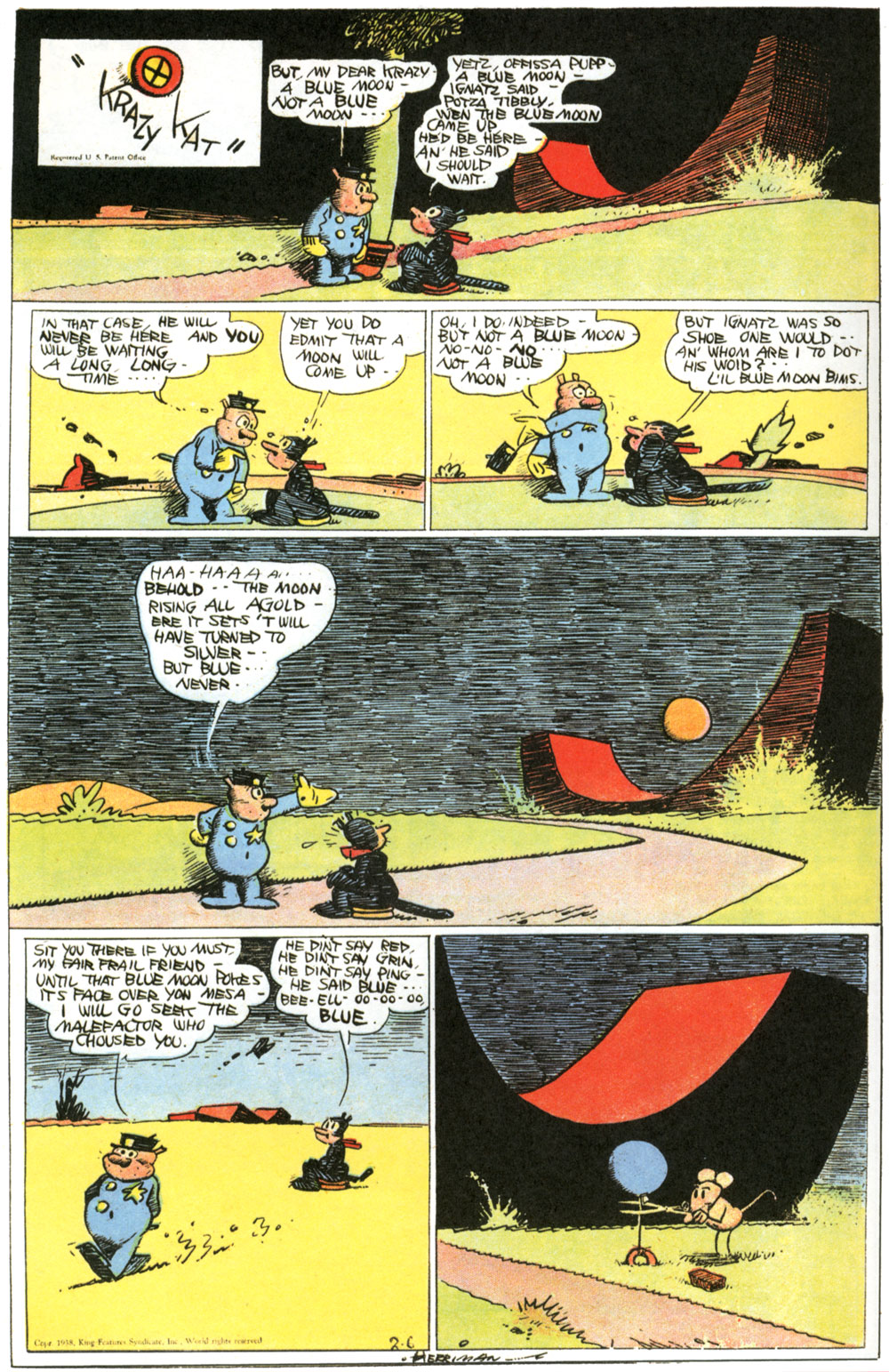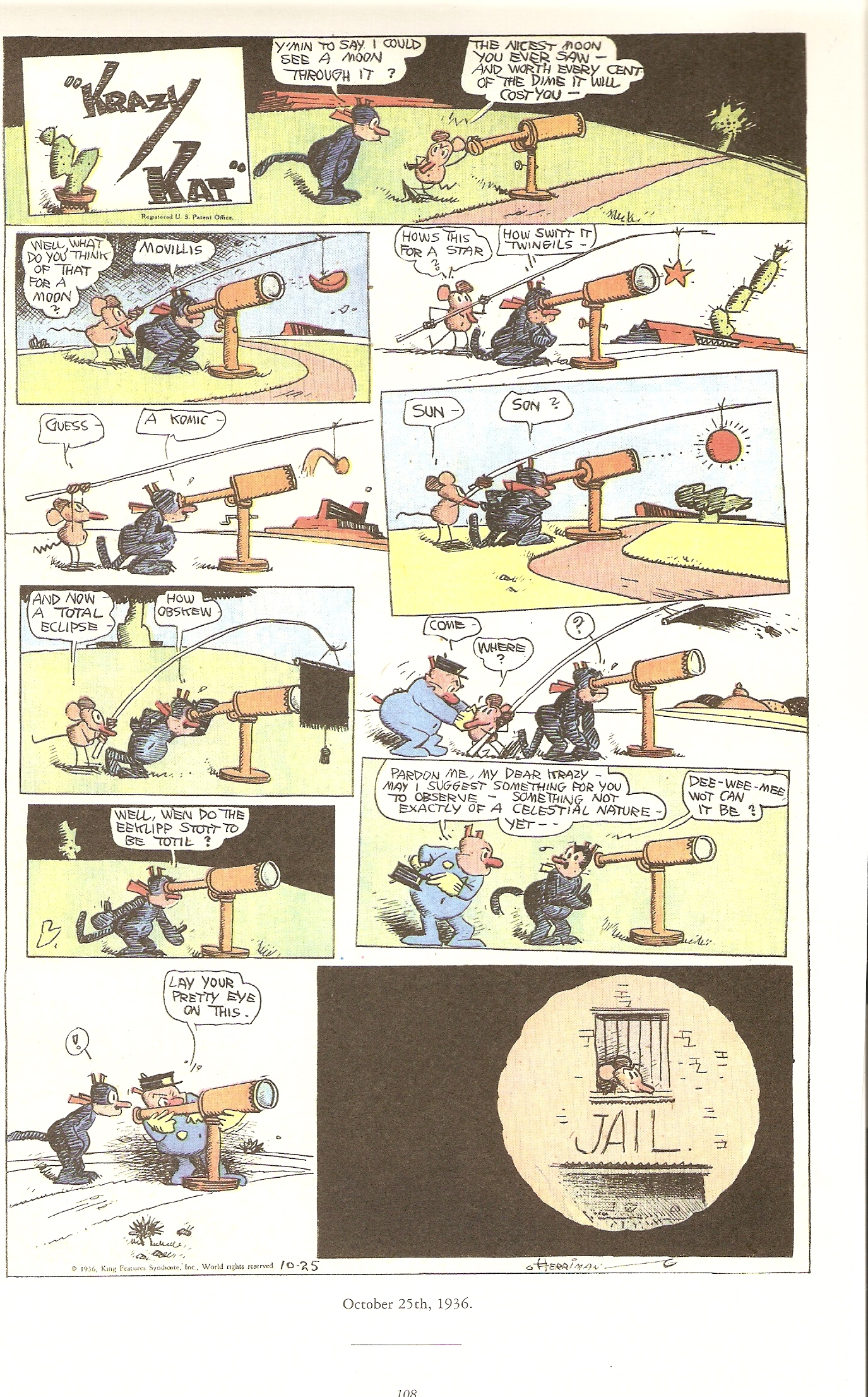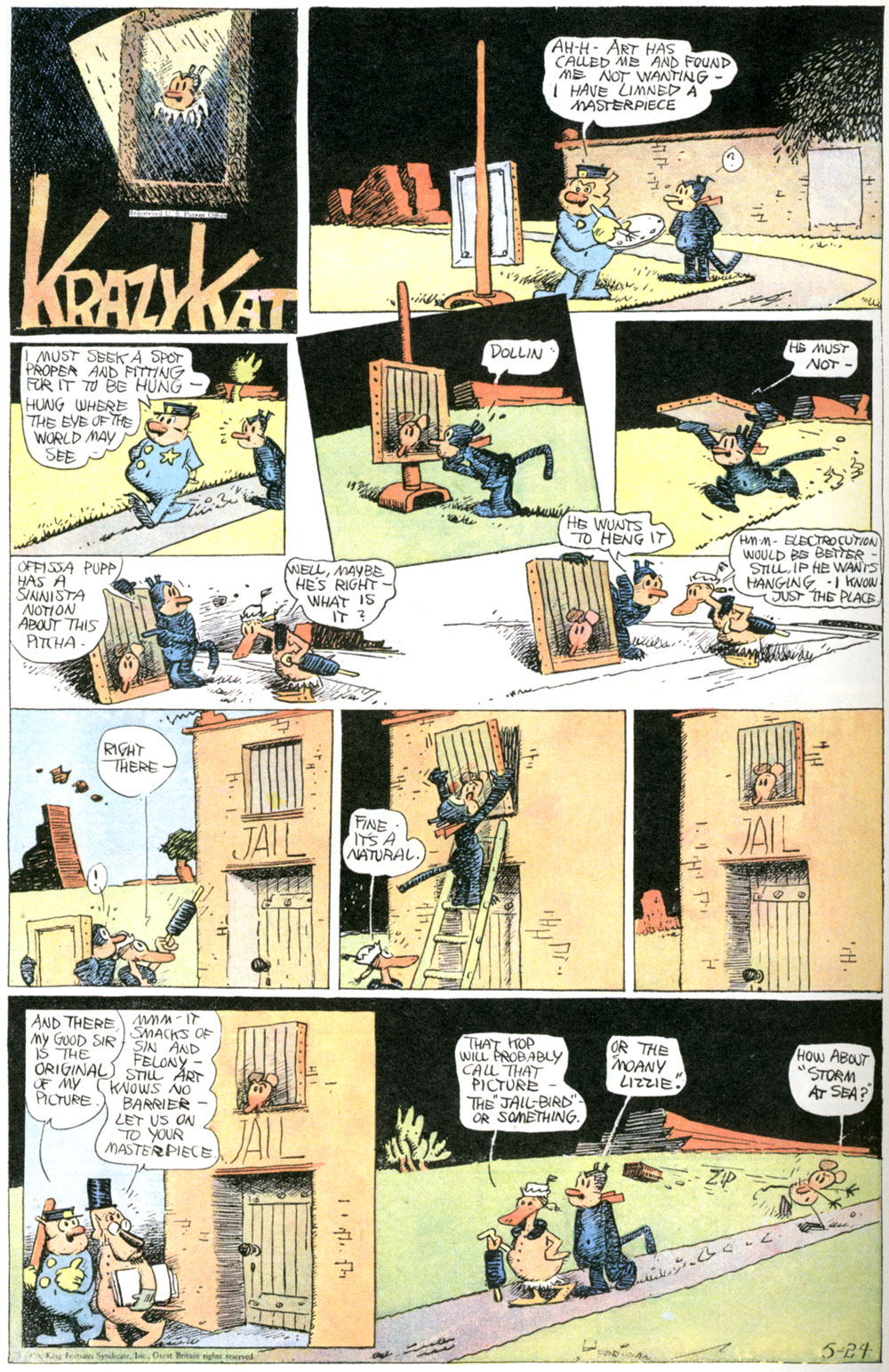Last week Eric Berlatsky (that’s my brother!) left a comment on the PPP Krazy Kat roundtable in which he argued that one of the hallmarks of the strip is the way that settings and backgrounds are so unstable. “Everything “behind” the characters is constantly changing and in flux without any rhyme or reason,” he says. ” “Instability” seems to be the watchword of the strip, with the possible exception of the “solidity” of Ignatz’s brick itself.”
Eric talks about this in regards to the strips’ social positioning; the queer BDSM Kat/Ignatz/Pup triangle, and/or Herriman’s own fluid, possibly closeted or masked relationship to African-American identity. However, it seems to me that it could also be read formally rather than culturally.
For example, take this strip I pulled from the internet at random:
As Eric says, the background here shift insistently. In the first panel, Krazy and pup are positioned at night beside a tree on a straight road, with a curved rock formation off in the distance. The two panels below seem to be in daylight (the color of the sky blurring into the color of the ground from the panel above(. The tree disappears, and there are different rock formations (and what looks like a volcano) off in the distance. Then, in the next large panel, we see the (formerly straight) road curving off towards the obelisk, from behind which a gold moon rises. The sky is no longer the solid black of the first panel, but is instead a mass of cross-hatchings, almost ostentatiously referencing the hand that drew it. All this time, Officer Pup is explaining, with much assertion and repetition, that the waiting Krazy will never see a blue moon; declaring his faith in a natural order even as the world around him haphazardly shuffles trees and roads, creativity sliding out from under the rotund figure of law and order, who looks not unlike a big blue moon himself. Finally, Pup exits, and as Krazy lurches into quasi song (“Bee-Ell-oo-oo-oo Blue”) we see behind the monument (or did the monument just move over?) where Ignatz prepares to launch an ersatz blue moon balloon. Surely Krazy here is the reader, not so much gullible as eager to be gulled, while Ignatz is Herriman, the artist arranging and rearranging the props for the delight/confounding of all us waiting Kats. The arrangement of the two moons, one above the other on the page despite the alteration of all other visual cues, is perhaps the tell; the real paper moon is as fake as the fake paper moon, or perhaps even slightly more fake, since the blue acknowledges its artifice.
Stumbling on such a clearly self-referential strip wasn’t an accident I don’t think. Here’s another I picked out.
Again, Kat as reader, Ignatz as creator, with the changing delights before the lens mirroring the giddy changes in background, as day swaps for night, trees replace rock formations, and the road arcs one way and then the other. Krazy even guesses that one misshapen piece of tschotskes is a “Komic”, in case we missed the joke. And then, the final turn-around, officer pup calls an end to the proceedings and the comic, returning to one of the strip’s most stable iconic images; Ignatz locked up in the dull jail, the world all bricked up and stolid till Ignatz (or Herriman) gets out to draw the next page.
And then there’s this:
That center second line panel tilts to create a straight frame within a crooked frame, a deliberate drawing of a drawing, created this time by Pup and placed in its jailhouse place by Krazy — even the creator is unstable, and who is creating who. In the final row, the left-hand panel is inset, like a painting against the black sky, so that the prison wall with the fake Ignatz painting looks itself like a cardboard facade. Krazy and the duck walk towards the fake painting on the fake drawing, burbling garbled names of masterpieces, while Krazy throws that brick against the left to right run of the reading. Roy T. Cook suggested that the brick’s reverse zip “highlights the artificiality” of Ignatz’s action. Everything, in short, is what it shouldn’t be; the genius of the artist is to krazily wrong all rights.
Adrielle Mitchell talked in her post about the way that George Herriman reshaped the comics canon; in comments Alex Buchet points out that Krazy Kat is in many ways in the high art canon, much loved by people like Juan Miro and Gertrude Stein.
Given that, perhaps Krazy Kat’s place in the canon is in some ways to create the notion of a canon,or to make a strip which demands a kind of canonicity. Art presents itself as art through the assumption of individual afflatus — the vision as meme. Krazy Kat, in the insistence of its artifice, is almost(?) a parody of avant garde brio, virtuosically creating a new world with every panel. Herriman makes a space for comics creator as genius because he drew himself as genius, high art in a blue moon.



Curious (and tangential), has anybody read Jay Cantor’s novel, Krazy Kat? I read it several years ago, before I was more familiar with the strip and don’t remember it well (I gave it the quick grad school read to see if it worked for a project I eventually abandoned) – but I seem to recall that in working and developing Krazy’s world, he was doing his own reading of the shifting backgrounds, the love-triangle and the significance of the brick.
This tendency was part of Krazy Kay from the very first years, especially in the self-referential dailies.
Ignatz would usually play the part of the realist/formalist (to, I supose, Krazy’s idealist/representationalist[?]). In their banter, the mouse would highlight the materiality of the strip — which often made him more able to manipulate the strip’s unstable, falsifiable, and falsifying reality.
December 25, 1919: “We’ve been in this paper all the time.”
April 1, 1919: “You’re only an idea, expressed in ink on paper.”
April 5, 1919: “That was no tunnel.” “It’s only an excuse for our meneger to get out of making pitchers.”
March 12, 1919: Ties a word balloon to Krazy’s tail.
December 16, 1918: Hiding in a inkcloud.
November 02, 1918: Ignatz steals a star
October 29, 1918: Star or scrap paper?
“How could it be aught were it not thus?” Another great self-referential piece, from 1922: http://www.comicstriplibrary.org/images/comics/krazy-kat/krazy-kat-19220416-s.png